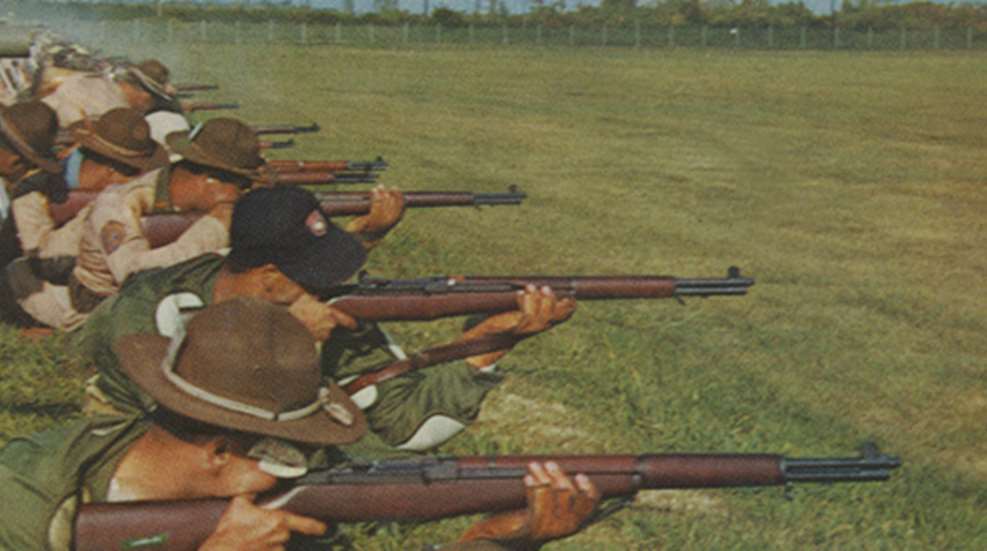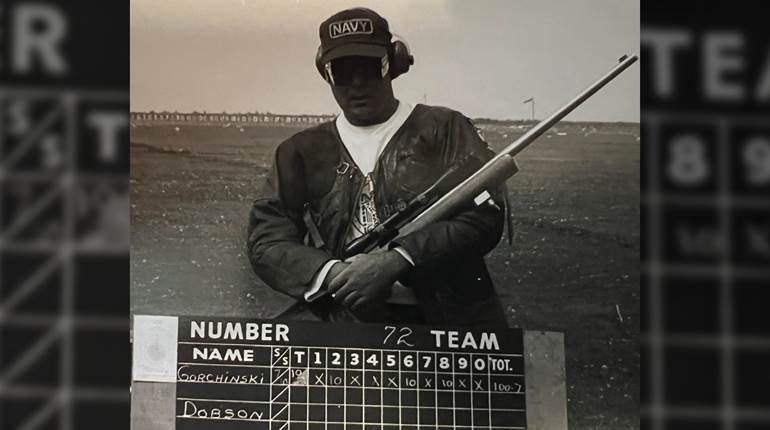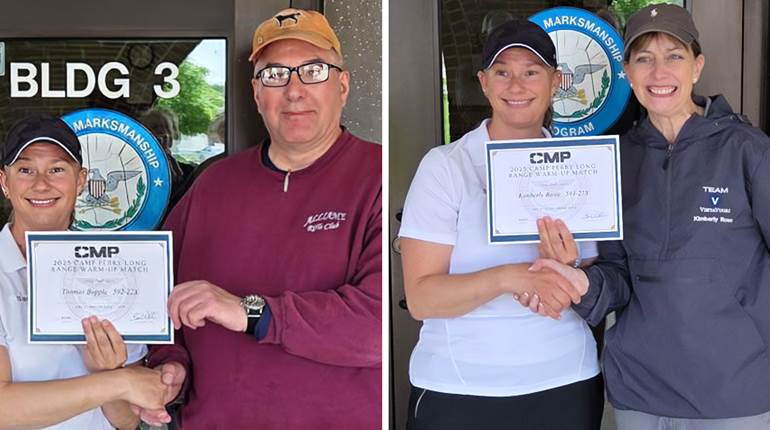
From the September, 1947 issue of American Rifleman
With the possibility of .30 caliber match shooting again in the offing, interest is increasing in the one question which seems to loom in the mind of the civilian rifleman. Will the Garand, he asks, shoot as well as the old Springfield? Will it be possible to develop a “National Match” Garand that will hold up at 1,000 yards?
To get authoritative answers to these questions, the NRA sent Staffman John S. Rose, of its technical service, to Springfield Armory, with orders to get the answers from the one man who is qualified to give them—John C. Garand. Here, for the first time in print, are the opinions of the Canadian-born inventor of the United States M1 service rifle.
During the years spent designing what is now the M1 rifle, I came to realize that if the gun were ever adopted as the standard for the U.S. Services, the question of accuracy for match shooting would eventually have to be faced and solved. Thus, during the twenty-nine years spent at Springfield Armory, I have always studied the matter of accuracy as much as circumstances would permit. The fact that my work was carried on principally in the Experimental Department, in close association with the personnel who were charged each year with the work of testing the National Match Springfield, put me in a position to see and observe much regarding rifle accuracy, and to benefit by the close friendship and confidence of such men as A.L. Woodworth, William L. Bull and many others.
From the stories of the old-time shooters it seems the M1903 Springfield was regarded with keen disfavor when it first displaced the Krag, with its thirty-inch barrel, long sight radius, and rather mild report and recoil was a pleasant rifle to shoot and did very well indeed at the longer ranges. The “new” Springfield of those days had a most annoying habit of losing its accuracy suddenly at the most unexpected times on account of the metal fouling which often built up in the barrel after just a few shots with the high-velocity cupro-nickel jacketed bullet.
Some of these disadvantages, such as the short barrel, were more imaginary than real; others, notably the metal fouling, were overcome and passed rapidly into the realm of memory. In the end the M1903 Springfield, like the Krag that had preceded it, became a highly popular target weapon and was hailed as the most accurate military rifle in the world.
I feel confident that history will repeat itself, and in years to come the Garand rifle will take its place as a superbly accurate match rifle.
Splendid weapon that it was, the 1903 Springfield had a few rather serious disadvantages as a target rifle, and I determined to avoid these as far as possible in my new design. One bad point is the fact that in the event of a punctured primer or a gas leak, there is a chance of hot gas or small particles of brass being blown back into the shooter’s face.
The breech mechanism design of the M1 fortunately lends itself to a construction in which the breech is completely closed at the rear end, thus absolutely preventing any blowback of particles through the mechanism. Moreover, the breech recess and bolt are purposely so proportioned that any gas which might leak out around the bolt would be deflected upward above the shooter’s eyes.
Another point about the Springfield which is rather unfavorable to uniform accuracy is the full length military stock, with the action held at the rear by the two guard screws and at the front end also by the upper band. In these rifles there was a considerable amount of trouble from binding of the barrel by the upper band due to the swelling of the wood in damp weather. The remedy finally adopted for match Springfields was to free the wood around the barrel at the upper band, and as a preventive of accidental contacts, to bed the rifle in the stock so that the bottom of the barrel rested firmly on the wood with a pressure of from six to ten pounds. This worked well, but there was always the chance that the long stock would swell or warp and press on on side or the other of the barrel with a consequent change of center of impact.
It has been my feeling, confirmed by many years of actual experience, that the most favorable condition for accuracy is to have only the receiver secured in the stock, with the barrel projecting freely, held solely by its bearing in the receiver.
It would be ideal, of course, to have the barrel free of all projections and to have the barrel free of all projections and to have no objects hung on it, but that is impossible with a gas-operated semiautomatic. However, it seems that while any object attached to the barrel will change the location of the group center, it will not change the group size, so long as the object is fixed in its relation to the barrel. Thus, the M1 rifle will shoot the same size group with the gas cylinder attached as with it removed, provided the cylinder cannot shift its position on the barrel.
It was partly in consideration of the principles mentioned above that the M1 rifle was designed with the front handguard separate from the stock, and with the gun clamped to the stock only at the receiver and more or less floating free elsewhere.
There are two main principles to remember in trying to arrange for maximum accuracy with the M1. The first is that, as far as possible, nothing should touch the barrel at all except objects that are fastened immovably to it, such as the gas cylinder and the lower band. Particular care must be taken to secure these so they cannot shift their position. The second is that the wood and metal pieces that are positioned along the barrel should have sufficiently generous clearances to prevent any chance of binding as the barrel heats up from firing. It takes very little firing to raise the temperature 500 degrees Fahrenheit. This means an increase of length over .05 inch between the receiver and the upper band. A reference to the lettered photo which follows will make it plain that unless the necessary clearances exist, such a change in the barrel length would almost surely open up the group on the target.
First, take the point D where the stock ferrule locks into the lower band. If the stock is long enough so that when the gun is assembled, there is a forward pressure by the stock on the lower band at this point, there will be a tendency for the barrel to be bent upward. As the gun heats up in firing, the barrel will lengthen, and thus pressure will be relieved, allowing the barrel to bend downward again. This will cause the shots to drop on the target. Hence, one of the conditions necessary for small groups is a fore and aft clearance at the point D. This clearance can be anything up to one-sixteenth inch and should certainly never be less than .01 inch.
Another place where there should be plenty of clearance is at the two ends of the rear handguard, at the points marked A on the photograph. If there is pressure at these points when the gun is cool, it will be relieved as the barrel heats, and the change of conditions will change the location of the shots on the target.
Two more points at which a tight fit is detrimental to accuracy are those marked B, where the ends of the upper band guard should be free enough for longitudinal play to be felt easily when it is pushed forward and backward by hand. It should also be quite free over the barrel and operating rod so that there is no chance for the wood to make contact with either of these parts.
The gas cylinder must have quite a snug fit on the barrel at the point C and must leave a clearance at the rear end where the ring fits over the barrel at the forward one of the two points marked B. Any absence of a proper gas seal between the barrel splines and the mating portion of the gas cylinder at point C can be overcome by plating the barrel with hard bronze or nickel. The ring at the rear end of the gas cylinder that surrounds the barrel should have at least .001 inch clearance. It is preferable to have this loose enough so that a strip of thin paper can be passed between this ring and the barrel.
The lower band should be fixed quite firmly to the barrel. Clearance between the lower band and operating rod at point D should be such that there is no binding contact between the band and rod as the rod is driven to the rear.
For best accuracy, the action should be firmly bedded in the stock. A tightly locking trigger guard should draw the rear end of the receiver down to rest firmly on the slightly raised flat portion of the stock at that point.
That portion of the stock inletting designed to accommodate the recoil shoulders of the receiver should provide balanced support and should not permit any lateral movement. Selection of stocks or possibly the use of shims would correct most cases of this nature.
The urgent necessity for the utmost speed in wartime production has sometimes resulted in rear sights having too much play for best target accuracy. Any excess clearance between aperture and rear sight base can be corrected by plating with hard bronze or nickel.
The time required for the hammer to fall is about the same as the lock time in the 1903 Springfield, or about the .0057 second. However, a sharper hammer blow will give faster and more uniform ignition, and will tend to produce smaller groups. The present mainspring can be replaced to give more tension and hence a smarter hammer blow, which will result in faster ignition and lock time, which is conducive to accuracy. It is also an advantage to the shooter to have an extremely short time elapse between trigger pressure and primer indentation. Obviously the disarrangement of aim can be kept to a minimum with faster hammer fall.
The occasional “long trigger pull” may be corrected through the use of a stone in the hands of a trained armorer or gunsmith. Rather than the sear, it is the dressing of the front hammer hooks that removes M1 “creep.”
If a star gauge is available, the point to look for is any slight tightness of the groove diameter right at the muzzle. This may occur in manufacture as the rifling head wears, and is not good for the accuracy. If any such constriction does exist, it will be in the grooves only and can be removed by careful lapping, taking care to enlarge the groove diameter only and not the land diameter.
It is well to check rifles to see that the forward end of the piston rod clears the gas cylinder lock screw by not less than .05 inch. Insufficient power results if the gas must act on the piston from a chamber less than .05 inch deep. This can be checked by placing a single pellet of B-B shot in the gas cylinder to be compressed by the piston as the action is allowed to slam shut. By measuring the flattened pellet the clearance may be determined.
The points mentioned above cover only a few of the steps that may ultimately be taken to make the M1 rifle into a first-class target instrument. I am confident that it is potentially as accurate as any service rifle ever made, and that with the same care that has been bestowed on the 1903 National Match rifles in the past it can be made to give long-range accuracy that will excel that of any other military arm.





































